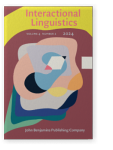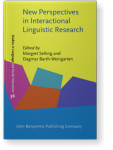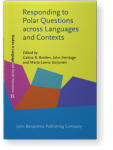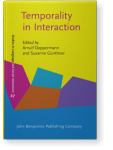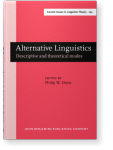Barbara A. Fox
List of John Benjamins publications for which Barbara A. Fox plays a role.
Book series
Journal
ISSN 2666-4224 | E-ISSN 2666-4232
Titles
Studies in Anaphora
Edited by Barbara A. Fox
[Typological Studies in Language, 33] 1996. xii, 518 pp.
Subjects Functional linguistics | Typology
Voice: Form and Function
Edited by Barbara A. Fox and Paul J. Hopper
[Typological Studies in Language, 27] 1994. xiii, 377 pp.
Subjects Discourse studies | Functional linguistics | Pragmatics | Theoretical linguistics
2025 Chapter 2. On granularity in grammar and action Grammar in Action: Building comprehensive grammars of talk-in-interaction, Steensig, Jakob, Maria Jørgensen, Jan K. Lindström, Nicholas Mikkelsen, Karita Suomalainen and Søren Sandager Sørensen (eds.), pp. 26–46 | Chapter
In this study, we explore the relevance of granularity to the study of grammar-in-interaction, with special reference to the writing of an online grammar (cf. Steensig, et al. 2023). In CA/IL research, it routinely occurs that a form or action is described and analyzed at one level of detail,… read more
2024 What to do next: Should I and ((Do) you) want me to in joint activities in American English New Perspectives in Interactional Linguistic Research, Selting, Margret and Dagmar Barth-Weingarten (eds.), pp. 20–48 | Chapter
The starting point of most prior research on action formation and ascription is either a social action or a linguistic form. In contrast, our study will demonstrate analytic and methodological implications and cross-linguistic perspectives for Interactional Linguistics research of starting with… read more
2024 A multimodal approach to grammatical aspect: Embedded depictions and their aspectual characteristics as interactional resources Interactional Linguistics 4:2, pp. 225–256 | Article
This paper offers a multimodal approach to grammatical aspect, traditionally seen in linguistics as a verbal-morphological category. Using conversation analysis and interactional linguistics, we take as our object of study turn completions done with bodily movements and non-lexical… read more
2023 Chapter 12. Do English affirmative polar interrogatives with any favor negative responses? Responding to Polar Questions across Languages and Contexts, Bolden, Galina B., John Heritage and Marja-Leena Sorjonen (eds.), pp. 350–376 | Chapter
In research on talk-in-interaction, English affirmative polar interrogatives with any have been argued to favor a negative response, with supporting data drawn largely from medical interactions. Considering a range of mundane interactional settings, we find that the response favored by an… read more
2021 The grammar of proposals for joint activities Interactional Linguistics 1:1, pp. 123–151 | Article
The action of proposing has been studied from various perspectives in research on talk-in-interaction, both in mundane as well as in institutional talk. Aiming to exemplify Interactional Linguistics as a drawing together of insights from Linguistics and Conversation Analysis, we explore the… read more
2020 Chapter 6. Asserting no-problemness in Spanish: ‘No hay (ningún) problema’ and the study of noun phrases in interaction The ‘Noun Phrase’ across Languages: An emergent unit in interaction, Ono, Tsuyoshi and Sandra A. Thompson (eds.), pp. 119–152 | Chapter
While much is known about noun phrases from morphosyntactic and typological perspectives, the study of nominal elements in interaction is just beginning. We contribute to this new area by exploring the interactional functions of the Spanish indefinite determiner ningún (‘any’, ‘no’) in the… read more
2017 Morphological self-repair: Self-repair within the word Studies in Language 41:3, pp. 638–659 | Article
In this study we explore patterns of same-turn self-repair within the word, across ten typologically and areally diverse languages. We find universal processes emerging through language-specific resources, namely: recycling is used to delay a next item due, while replacement is used to replace… read more
2015 Ephemeral Grammar: At the far end of emergence Temporality in Interaction, Deppermann, Arnulf and Susanne Günthner (eds.), pp. 95–120 | Article
Drawing on the theoretical and methodological approach of Conversation Analysis (CA) and aiming to contribute to research on Emergent Grammar (e.g., Hopper 1987, 2011; Bybee and Hopper 2001) and sequentially specific grammar (Schegloff 1996; Fox 1994; Thompson et al. to appear), this chapter takes… read more
2013 Units and/or Action Trajectories? The language of grammatical categories and the language of social action Units of Talk – Units of Action, Szczepek Reed, Beatrice and Geoffrey Raymond (eds.), pp. 13–56 | Article
Responding to Sacks et al.’s 1974 call for linguists to join in the study of resources for turn construction, the authors of this chapter long ago took on turn formulation as an issue which linguists must account for. In this chapter, we return to this aspect of CA’s charge to linguists, noting… read more
2010 Multiple practices for constructing laughables Prosody in Interaction, Barth-Weingarten, Dagmar, Elisabeth Reber and Margret Selting (eds.), pp. 339–368 | Article
This study explores a range of interrelated semiotic resources for constructing a “laughable,” which we define as one or more utterances proffered by a speaker and inviting recipient laughter or other laugh related displays. These semiotic resources, in and around the talk, include a range of… read more
2010 Introduction Fillers, Pauses and Placeholders, Amiridze, Nino, Boyd Davis and Margaret Maclagan (eds.), pp. 1–10 | Article
2007 Relative Clauses in English conversation: Relativizers, frequency, and the notion of construction Studies in Language 31:2, pp. 293–326 | Article
This paper is a usage-based study of the grammar of that set of English Relative Clauses with which a relativizer has been described as optional. We argue that the regularities in the use of relativizers in English can be seen as systematically arising from pragmatic-prosodic factors, creating… read more
2004 "Getting past no": Sequence, action and sound production in the projection of no-initiated turns Sound Patterns in Interaction: Cross-linguistic studies from conversation, Couper-Kuhlen, Elizabeth and Cecilia E. Ford (eds.), pp. 233–269 | Article
2002 On the embodied nature of grammar: Embodied being-in-the-world Complex Sentences in Grammar and Discourse: Essays in honor of Sandra A. Thompson, Bybee, Joan L. and Michael Noonan (eds.), pp. 79–99 | Article
2001 An exploration of prosody and turn projection in English conversation Studies in Interactional Linguistics, Selting, Margret and Elizabeth Couper-Kuhlen (eds.), pp. 287–316 | Article
1996 Interactional Motivations for Reference Formulation: He had. This guy had, a beautiful, thirty-two O:lds Studies in Anaphora, Fox, Barbara A. (ed.), pp. 145–168 | Article
1996 Practices in the construction of turns: The “TCU” revisited Interaction-based studies of language, Ford, Cecilia E. and Johannes Wagner (eds.), pp. 427–454 | Article
1995 The Category ‘S’ in English Conversation Discourse, Grammar and Typology: Papers in honor of John W.M. Verhaar, Abraham, Werner, T. Givón and Sandra A. Thompson (eds.), pp. 153–178 | Article
1995 A syntactic exploration of repair in English conversation Alternative Linguistics: Descriptive and theoretical modes, Davis, Philip W. (ed.), pp. 77–134 | Article
1994 Active Voice and Middle Diathesis: A Cross-Linguistic Perspective Voice: Form and Function, Fox, Barbara A. and Paul J. Hopper (eds.), pp. 1–22 | Article
1987 Anaphora in popular written English narratives Coherence and Grounding in Discourse: Outcome of a Symposium, Eugene, Oregon, June 1984, Tomlin, Russell S., pp. 157–174 | Article
1984 The Discourse Definition of Ergativity Studies in Language 8:1, pp. 1–34 | Article
1981 Body Part Syntax: Towards a Universal Characterization Studies in Language 5:3, pp. 323–342 | Article

